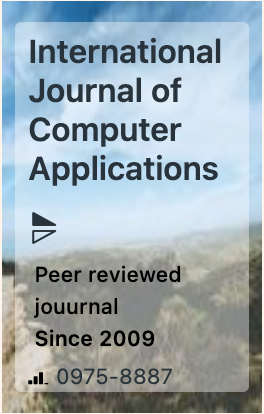The week's pick
Random Articles
Reseach Article
Deep Learning for Image Analysis: Trends, Challenges, and Future Directions
| International Journal of Computer Applications |
| Foundation of Computer Science (FCS), NY, USA |
| Volume 187 - Number 9 |
| Year of Publication: 2025 |
| Authors: Jagdish Giri Goswami, Sarthak Kathait, Anshi Kothari |
 10.5120/ijca2025925052
10.5120/ijca2025925052
|
Jagdish Giri Goswami, Sarthak Kathait, Anshi Kothari . Deep Learning for Image Analysis: Trends, Challenges, and Future Directions. International Journal of Computer Applications. 187, 9 ( May 2025), 65-73. DOI=10.5120/ijca2025925052
Abstract
Image processing is essential across various fields such as health- care, security, remote sensing, forensics, and agriculture, enabling applications like anomaly detection, pattern recognition, scene understanding, and image segmentation. With over 80% of the world's digital data now in visual form, the need for scalable, intelligent solutions is greater than ever. Deep learning (DL) and convolutional neural networks (CNNs) are outperforming untraditional methods in tasks like tumor classification, forgery detection, and object localization with their inherent ability to learn and extract deep feature-level information. Advanced architectural models. We Only Look Once (YOLO), and hybrid models have achieved significant results—CNN-based diagnostic tools now surpass 95% accuracy in detecting cancers, while YOLO variants carry out real-time detection at over 30 FPS with high precision. In the field of image forensics, deep learning models can detect splicing and copy-move forgeries with an accuracy of over 90% by extracting fine-grained artifacts invisible to the human eye. However, the field still poses significant challenges, like the limited availability of annotated datasets, and high computational needs. In high-stakes fields like healthcare, this lack of interpretability raises ethical and practical concerns. Techniques like transfer learning and data augmentation partially improve results on smaller datasets, while Explainable AI (XAI) methods—such as Grad-CAM and SHAP—are becoming essential for model transparency, interpretability, and trustworthiness. Current research is focused on enhancing model-generalizability, interpretability, and fostering interdisciplinary collaboration. As these challenges are progressively overcome, deep learning is expected to fully unlock its transformative potential across diverse image-processing domains.
References
- Maryam M Najafabadi, Flavio Villanustre, Taghi M Khoshgoftaar, Naeem Seliya, Randall Wald, and Edin Muharemagic. Deep learning applications and challenges in big data analytics.
- Zahid Mahmood. Digital image processing: Advanced technologies and applications, 2024.
- Jagdish Giri Goswami, Image comparison with different filter banks on improved PCSM code, December 2016.
- Jagdish Giri Goswami, Performance analysis of image compression using progressive coefficients significance methods (pcsm), 2016.
- Minxiao Wang, Ning Yang, Dulaj H Gunasinghe, and Ning Weng. On the robustness of ml-based network intrusion detection systems: An adversarial and distribution shift perspective.
- Zhihao Zheng and Pengyu Hong. Robust detection of adversarial attacks by modeling the intrinsic properties of deep neural networks, 2018.
- Muhammad Imran Razzak, Saeeda Naz, and Ahmad Zaib, 2018.
- Lianpo Wang and Zhaoyang Lei. Deep learning-based speckle image super-resolution for digital image correlation measurement.
- Emad Ul Haq Qazi, Tanveer Zia, and Abdulrazaq. Deep learning-based digital image forgery, 2022.
- Jing Dong, Wei Wang, and Tieniu Tan. CASIA image tampering detection evaluation database, 2013.
- Nam Thanh Pham, Jong-Weon Lee, Goo-Rak Kwon, and Chun-Su Park. Hybrid image-retrieval method for image-splicing validation.
- Thomas Bergs, Carsten Holst, Pranjul Gupta, and Thorsten Augspurger. Digital image processing with deep learning for automated cutting tool wear detection, 2020.
- Deepika Koundal and Rashid Amin. Deep learning in big data, image, and signal processing in the modern digital age, 2023.
- A Kuznetsov. Digital image forgery detection using deep learning approach, 2019.
- Guanghao Zhai, Yongjia Xu, and Billie F Spencer. Bidirectional graphics-based digital twin frame- work for quantifying seismic damage of structures using deep learning networks, 2025.
- Smaranda Belciug. Learning deep neural networks’ architectures using differential evolution. case study: medical imaging processing, 2022.
- Yofri Furqani Hakim and Fuan Tsai. Deep learning-based land cover extraction from very-high- resolution satellite imagery for assisting large-scale topographic map production, 2025.
- Abhishek Upadhyay, Narendra Singh Chandel, Krishna Pratap Singh, Subir Kumar Chakraborty, Balaji M Nandede, Mohit Kumar, A Subeesh, Konga Upendar, Ali Salem, and Ahmed Elbeltagi. Deep learning and computer vision in plant disease detection: a comprehensive review of techniques, models, and trends in precision agriculture, 2025.
- V Rajesh and P Sivakumar. Deep learning based denoising and enhancement of satellite images using DA-CNN and ORHE techniques, January 2025.
- Zilong Lian, Yulin Zhan, Wenhao Zhang, Zhangjie Wang, Wenbo Liu, and Xuhan Huang. Recent advances in deep learning-based spatiotemporal fusion methods for remote sensing images, 2025.
- Rahul Burange, Harsh Shinde, and Omkar Mutyalwar. An exhaustive review on deep learning for advanced landslide detection and prediction from multi-source satellite imagery, 2025.
- Mattia Casini, Paolo De Angelis, Eliodoro Chiavazzo, and Luca Bergamasco. Current trends on the use of deep learning methods for image analysis in energy applications, 2024.
- Xiaolin Zhuang and Tiemin Zhang. Detection of sick broilers by digital image processing and deep learning, 2019.
Index Terms
Keywords

